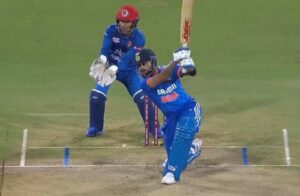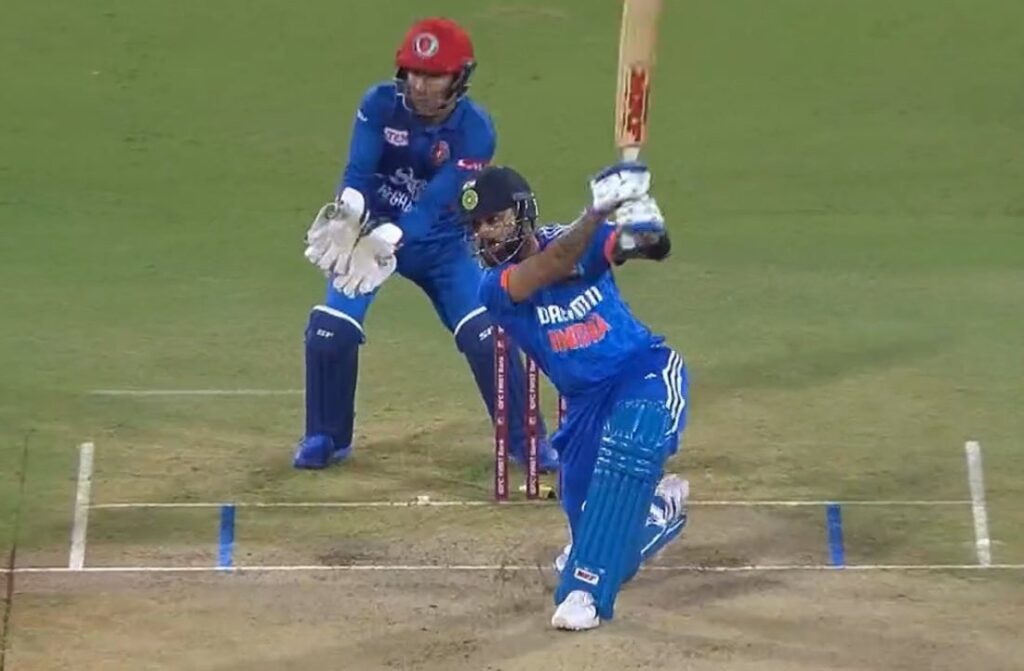
It was like a classical guitarist doing a punk-rock fusion. Mujeeb Ur Rahman bowled full outside off and Virat Kohli played a slog sweep wide of long-on for a four. When did he last play the shot? Great players can make certain improvisations that are beyond the lesser mortals. At 35 years of age, in the autumn of his T20I career, alteration has become Kohli’s brief. He needs to do things now that he hasn’t done previously to neuter the sceptics.
Three overs later, Kohli brought out the shot again, this time against the pace of Naveen-ul-Haq. The result was another boundary past wide long-on. It was remiss of the Holkar Stadium DJ not to play It’s Now or Never, for that was liberation from Elvis. Out there in the middle, Kohli was in a liberal hitting form. He raced to 29 off 15 balls, boasting a strike rate of 182.
At the other end, Yashasvi Jaiswal was going at a strike rate of 200-plus. And yet, he was a sideshow. On his return to the Indian T20 fold after a gap of 14 months – his last T20I before this was the T20 World Cup semi-final against England in Adelaide on November 10, 2022 – Kohli looked to be in excellent touch. The pitch was perfect, the evening dew eased the degree of difficulty even further and the Indian superstar had set himself up nicely for a big one.
From that perspective, Kohli’s dismissal was an anticlimax and he would be disappointed with the manner of it. But this was a new version of the man in this format, who shed the role of anchor to become enforcer. This is exactly what the selectors and the team management want him to be, with an eye on the T20 World Cup in the United States and the Caribbean later this year. The second T20I against Afghanistan at Indore provided ample indication that Kohli was ready to adapt.
Belatedly, India have changed their batting template in white-ball cricket. They no longer play an outdated brand of the game – keeping wickets in hand before going full throttle at the death. Fans have seen that at the 50-over World Cup and the recent T20Is.
Rohit Sharma presented himself as the Power Play enforcer in the ODI World Cup, but as Kohli, along with his captain, was brought back to the T20 side, questions were asked about whether the two seniors would be able to fit into the team’s new template in the shortest format as well. No top team plays an anchor in this format these days. Australia have dropped Steve Smith. England rejected Joe Root long ago. Kohli, in fact, got out at the wrong time, for it would have been interesting to see his approach in the middle overs.
Questions about his strike-rate against spin in the middle overs are pretty valid. His strike-rate during that phase against spin was just 110 in the last IPL. Over the last five IPLs, his strike-rate against spin has been second-lowest among batsmen who faced 50 deliveries or more. As Kohli departed for a 16-ball 29, fans missed out on his battle against Noor Ahmad and Mohammad Nabi; whether he would have carried forward his merry hitting even after the field was spread out. On the heels of four T20 World Cup failures for India as a team, Kohli and Rohit’s utility in this format was rightly put under the scanner. And their stature in Indian cricket notwithstanding, they will be under pressure to perform in T20 cricket.
A player of Shubman Gill’s hitting range had to be dropped in the second T20I. Ishan Kishan, a gun player in white-ball cricket, was left out of the T20 squad for reasons not related to cricket. When Suryakumar Yadav and Hardik Pandya return to the side, the likes of Shivam Dube and Rinku Singh might have to make way. Dube has been in scintillating form. In a short time, Rinku has emerged as the team’s finisher who can be trusted under pressure. India have an embarrassment of riches in this format, and Rohit and Kohli will have to show real intent in every T20 innings to keep the sceptics at arm’s length.
Rohit is yet to open his account in the ongoing series, but not much should be read into that. In the first game, he fell prey to Gill’s ball-watching, while on Sunday, he missed a pull. The intent was there for everyone to see. Kohli also revelled in his intent, as attested by Jaiswal during his post-match press conference. Going ahead – against tougher opponents at the T20 World Cup – this has to be the norm, for reverse gear no longer remains an option.





